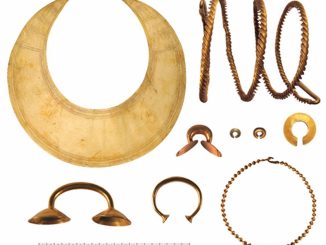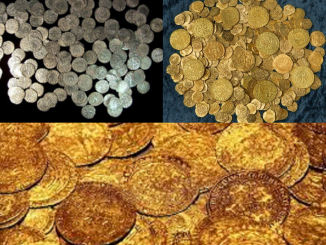The gold coin depicts a portrait of the Eastern Roman emperor with two stars around his head, possibly referring to the supernova explosion of 1054.

One of the two stars near the emperor’s head may be a supernova. Photo: cngcoins/Filipovic
In 1054, a star ran out of fuel and exploded in a bright supernova. Even though it was 6,500 light years away, the explosion was clearly visible in Earth’s sky for 23 days and several hundred nights afterward. The explosion is now known as SN 1054 and can still be observed in the Crab Nebula but requires a good telescope.
SN 1054 is so bright that Chinese astronomers call it a “guest star” – a term for a star that suddenly appears where there was no star before and then becomes invisible after a period of time. Sky watchers in Japan, Iraq, possibly even the Americas, recorded the sudden appearance of the explosion in writing and on rocks. But in Europe – where Emperor Constantine IX of the Eastern Roman Empire and Christianity had great influence – the big explosion in the sky was never mentioned.
In new research published in the European Journal of Science and Theology in August, a group of experts analyzed four Eastern Roman gold coins minted during the reign of emperor Constantine IX (1042 – 1055). While three coins depict only one star, the fourth coin with two bright stars surrounding the emperor’s head may be a subtle depiction of the supernova of 1054.
According to the research team, the emperor’s head may represent the Sun, the eastern star represents Venus, and the western star represents SN 1054 – a supernova that appeared for nearly a month in the sky at dawn. day, opposite Venus. The two stars may also represent the Eastern Orthodox and Western Catholic branches of Christianity, which split during the Great Schism of July 1054.
If the above explanation is correct and the gold coin indeed depicts SN 1054, then Byzantine scholars may have been forbidden to study or mention this supernova due to religious reasons. The Church may have a philosophical bias against any changes in the supposedly perfect and eternal night sky. Combined with the chaos of the Great Schism at that time, the church may have felt it was wise to ignore the supernova. However, it is more likely that a clever scholar has found a way to “circumvent the law”.
The team of experts also visited many museums to study 36 copies of the two-star coin and discovered that the size of the western star was inconsistent and seemed to shrink over time. This is likely intended to show SN 1054 fading in the sky.
These hypotheses are very reasonable but still lack clear evidence, the team said. The size and arrangement of the stars on the coin may represent something else, and just coincide with the appearance of a supernova. Additionally, there is no exact mint date, so it’s impossible to know if they were minted before or after the supernova.


